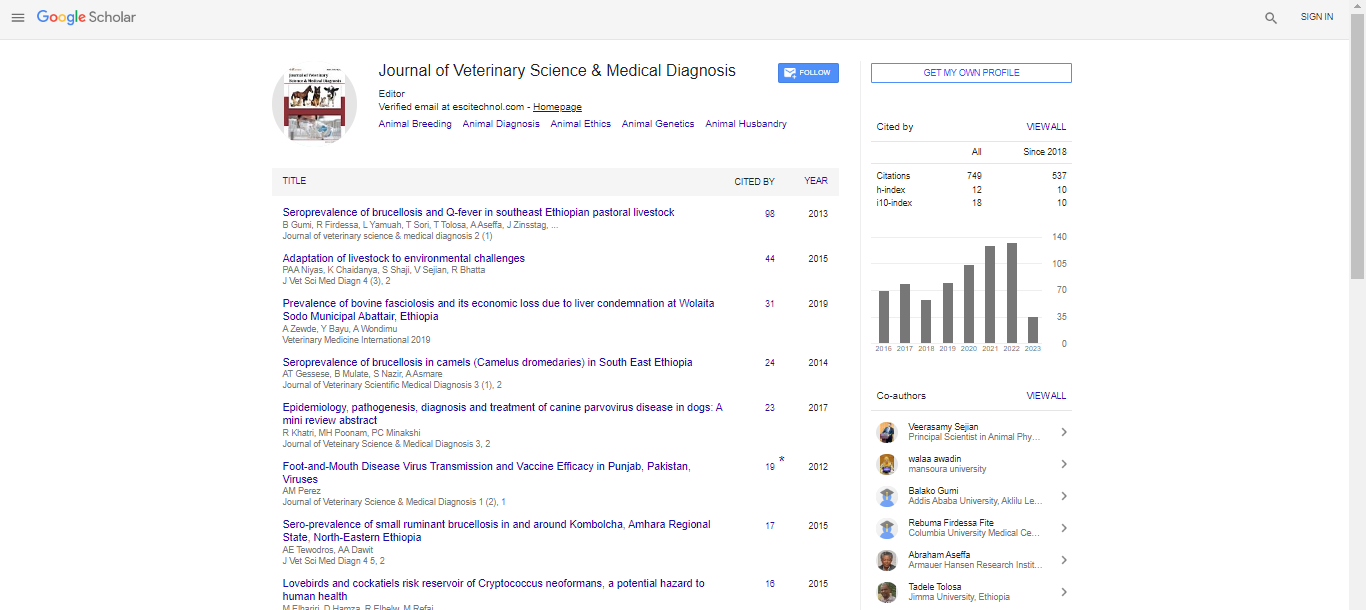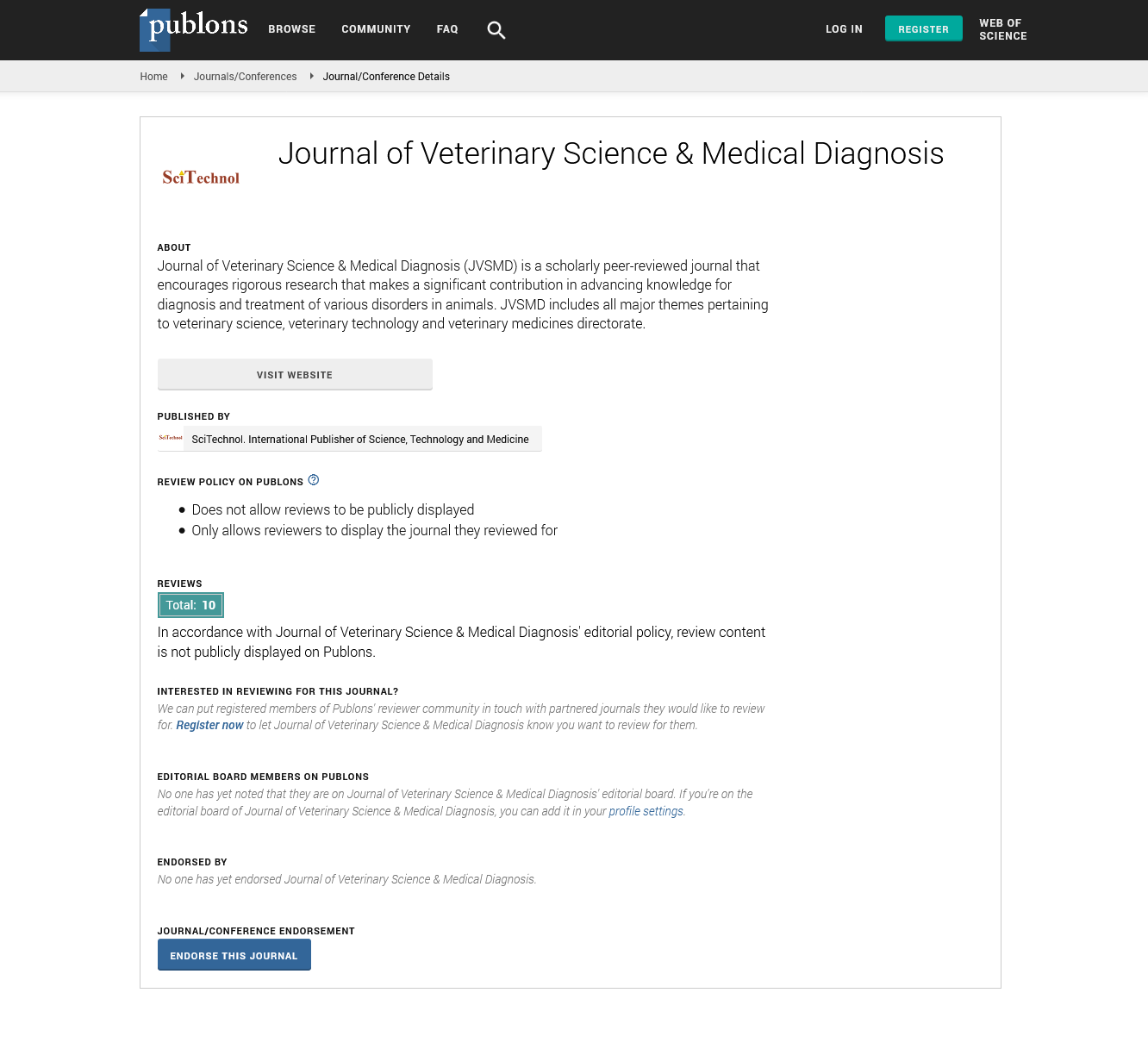Commentary, J Vet Sci Med Diagn Vol: 12 Issue: 1
Technology Implementation for Fertility Control in Wild Animals
Temesgen Getahun*
Department of Veterinary Microbiology and Public Health, Addis Ababa University, Oromia, Ethiopia
*Corresponding Author: Temesgen Getahun
Department of Veterinary
Microbiology and Public Health, Addis Ababa University, Oromia, Ethiopia;
E-mail: temesgen@eia.mic.et
Received date: 02 January, 2023, Manuscript No. JVSMD-23-89768;
Editor assigned date: 04 January, 2023, Pre QC No. JVSMD-23-89768(PQ);
Reviewed date: 18 January, 2023, QC No. JVSMD-23-89768;
Revised date: 25 January, 2023, Manuscript No: JVSMD-23-89768(R);
Published date: 03 February, 2023, DOI: 10.35248/2325-9590.23.12.100035.
Citation: Getahun T (2023) Technology Implementation for Fertility Control in Wild Animals. J Vet Sci Med Diagn 12:1
Description
Fertility control methods in animals are techniques used to manage animal populations by controlling the reproduction of animals. These methods are essential in maintaining a sustainable animal population, particularly in areas where the animal population has become too large, leading to negative effects on the ecosystem and human activities. There are several fertility control methods in animals, and they include hormonal methods, surgical methods, and immunological methods. Hormonal methods involve the use of hormones to control the reproductive system of animals. These hormones can be administered orally, through injections, or implants. Hormonal methods work by disrupting the hormonal balance of animals, thereby reducing their reproductive capacity. Hormonal methods are commonly used in livestock and domestic animals, such as dogs and cats. Surgical methods involve the removal of reproductive organs such as ovaries, testes, or the uterus of animals. This method is commonly used in animals that are difficult to manage or that are aggressive, such as wild horses or feral cats. Surgical methods are highly effective in controlling animal populations, but they require skilled veterinarians to perform the procedures.
Immunological methods are relatively new, and they involve the use of vaccines to control the reproductive system of animals. This method works by producing antibodies that target the reproductive hormones of animals, thereby reducing their fertility. Immunological methods are less invasive and have fewer side effects than hormonal and surgical methods. They are also effective in both male and female animals. Fertility control methods have several benefits. First, they help to manage animal populations, reducing the negative impact of overpopulation on the environment and human activities. They also reduce the need for culling, which can be inhumane and costly. However, fertility control methods also have some drawbacks. They can be expensive and require skilled personnel to implement. Some methods can also have side effects, such as hormonal imbalances or surgical complications. In addition, some animal populations, such as endangered species, require careful management to ensure their survival, and fertility control methods may not be appropriate for such populations.
Fertility control methods are essential in managing animal populations. The choice of the method used will depend on the animal species, the population size, and the environment. Hormonal, surgical, and immunological methods all have their advantages and disadvantages, and the most appropriate method will depend on the circumstances. The use of fertility control methods must be carefully managed to ensure the welfare of animals and the long-term sustainability of animal populations.
Fertility control methods in animals are used for a variety of purposes, including population management, disease control, and conservation efforts. Some examples of applications of fertility control methods in animals are Population management. In situations where animal populations exceed the carrying capacity of their habitats, fertility control methods can be used to limit the number of offspring produced. This is commonly done in the management of wild horse and burro populations in the United States, where contraception is used to reduce population growth rates. Fertility control can also be used as a tool for disease control in wildlife populations. For example, in areas where tuberculosis is a problem in badger populations, fertility control has been used to reduce the number of new badgers entering the population, and therefore the spread of the disease. In some cases, it can be used to help conserve endangered or threatened species. For example, in the case of the African elephant, contraception has been used to manage population growth in some areas where habitat loss and poaching have depleted populations and also be used in livestock management to control reproduction in animals. This can help prevent overgrazing and reduce the impact of livestock on the environment. Overall, fertility control methods in animals have a wide range of applications and can be an important tool for managing populations and conserving wildlife.
 Spanish
Spanish  Chinese
Chinese  Russian
Russian  German
German  French
French  Japanese
Japanese  Portuguese
Portuguese  Hindi
Hindi 
